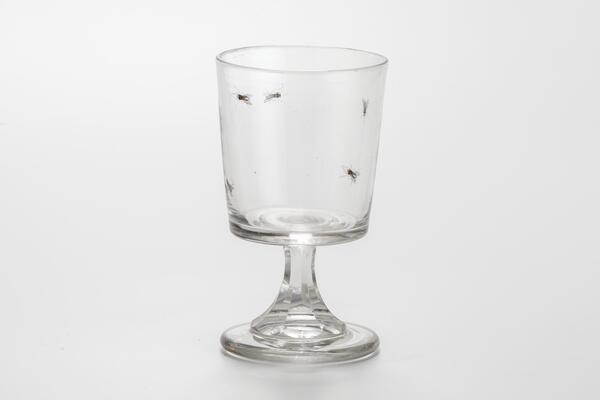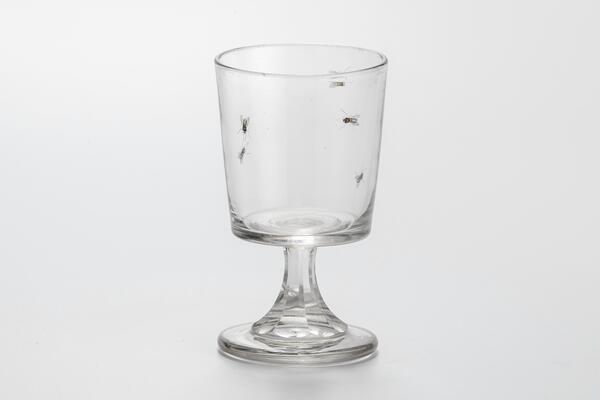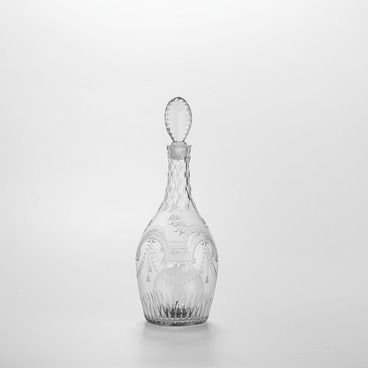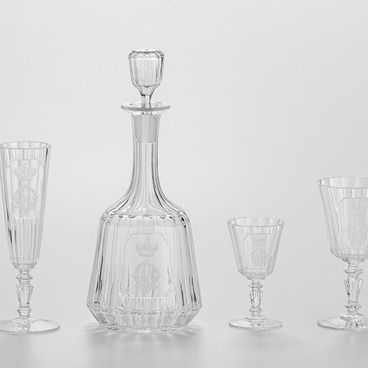The museum displays a smooth colorless glass with a frustum shape and a short stem decorated with cutting. It attracts attention with a very unusual image painted on the bowl — five strikingly realistic flies. The painting is made in polychrome, brown, light and dark grey colors and made to stick to the surface in the process of firing in a furnace.
This kind of “fun” tableware was quite common — it was a way to entertain guests during a party. Not anyone was treated to a drink from a set with flies. It was only offered to the guest who has consumed a substantial amount of alcohol and the others wanted to make some fun.
A colorless drink (vodka, for example) was poured into such a glass and made the image “alive”: candlelight, the optical properties of glass and the light alcohol intoxication created an illusion that the flies were real and floated in the glass. The attempts to drive the unwanted “guests” out were doomed, and the drunk guest who could not tell a painted fly from a real one was made fun of. Writers often used such expressions as “squeeze flies” or “hit flies” — these idioms meant “drinking” and “having a strong alcohol drink”.
Some researchers connect the etymology of these expressions with the “fly” game and the tradition to toast “luck with a fly.” Others claim that the phrases owe their origin to an even earlier expression — “they only squeeze flies” — used about people who had nothing to do. It was believed that those wealthy carousing noblemen spent their time in the same meaningless way. The third version has to do with the glasses that remained popular until the 20th century. A person who tried catching painted flies was said to have “hit a fly.”
The Bakhmetevsky factory glassware had the same high quality as the items that were produced in St. Petersburg. Unlike the elaborate and ceremonial designs that were common in the capital, the Bakhmetevsky patterns were vivid and had a provincial appeal, which did not diminish their decorative qualities.
The decorations included not only fun motifs — they also featured views of mansions, scenes of quiet walks, fishing, secluded hunting, and fruit still lifes. There were all kinds of ribbons and bows, elaborate monograms and lush roses, cupids and pierced hearts, and even love addresses. All these details created an atmosphere of intimacy and introduced a touch of sentimentality.
This kind of “fun” tableware was quite common — it was a way to entertain guests during a party. Not anyone was treated to a drink from a set with flies. It was only offered to the guest who has consumed a substantial amount of alcohol and the others wanted to make some fun.
A colorless drink (vodka, for example) was poured into such a glass and made the image “alive”: candlelight, the optical properties of glass and the light alcohol intoxication created an illusion that the flies were real and floated in the glass. The attempts to drive the unwanted “guests” out were doomed, and the drunk guest who could not tell a painted fly from a real one was made fun of. Writers often used such expressions as “squeeze flies” or “hit flies” — these idioms meant “drinking” and “having a strong alcohol drink”.
Some researchers connect the etymology of these expressions with the “fly” game and the tradition to toast “luck with a fly.” Others claim that the phrases owe their origin to an even earlier expression — “they only squeeze flies” — used about people who had nothing to do. It was believed that those wealthy carousing noblemen spent their time in the same meaningless way. The third version has to do with the glasses that remained popular until the 20th century. A person who tried catching painted flies was said to have “hit a fly.”
The Bakhmetevsky factory glassware had the same high quality as the items that were produced in St. Petersburg. Unlike the elaborate and ceremonial designs that were common in the capital, the Bakhmetevsky patterns were vivid and had a provincial appeal, which did not diminish their decorative qualities.
The decorations included not only fun motifs — they also featured views of mansions, scenes of quiet walks, fishing, secluded hunting, and fruit still lifes. There were all kinds of ribbons and bows, elaborate monograms and lush roses, cupids and pierced hearts, and even love addresses. All these details created an atmosphere of intimacy and introduced a touch of sentimentality.





